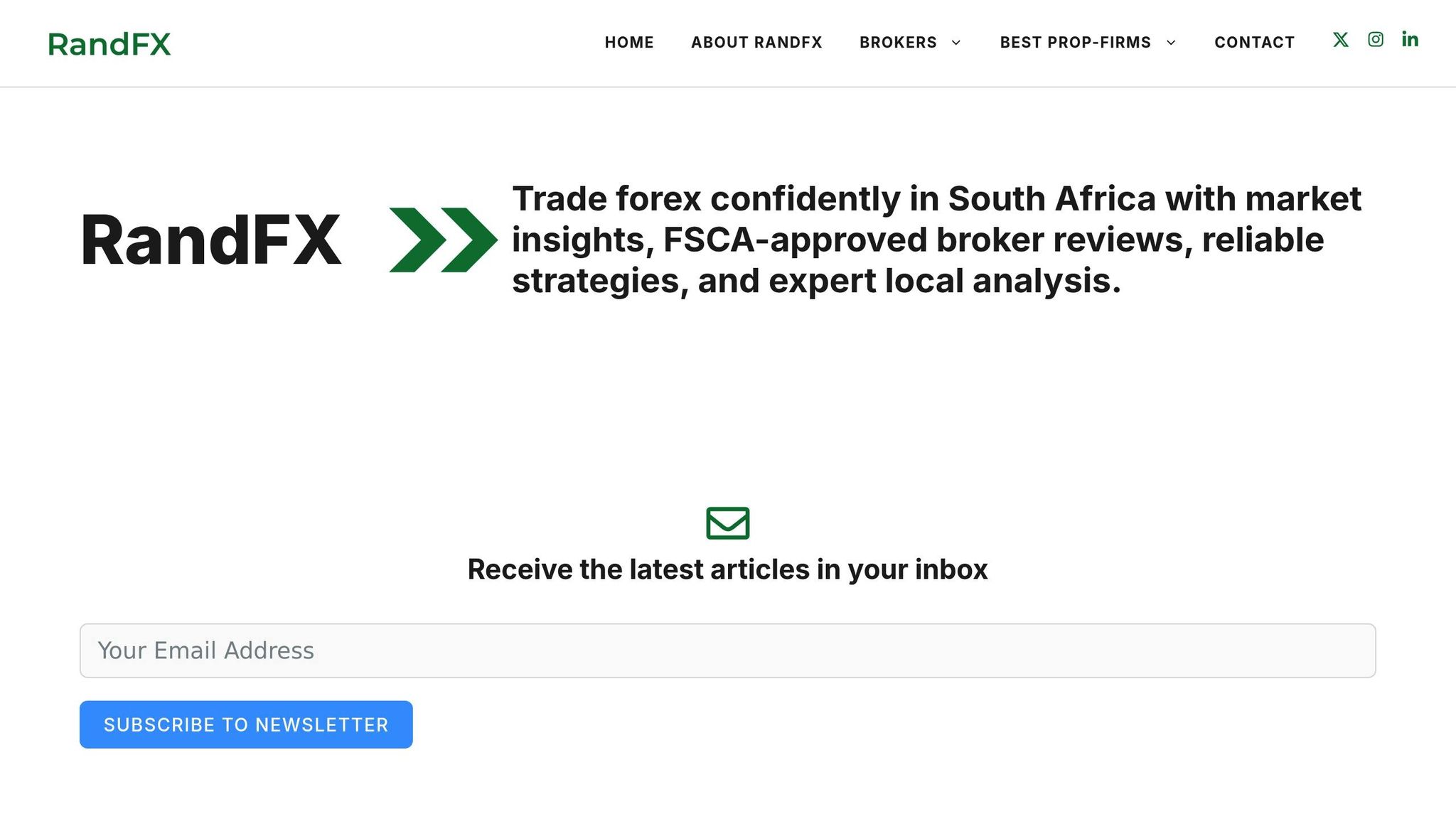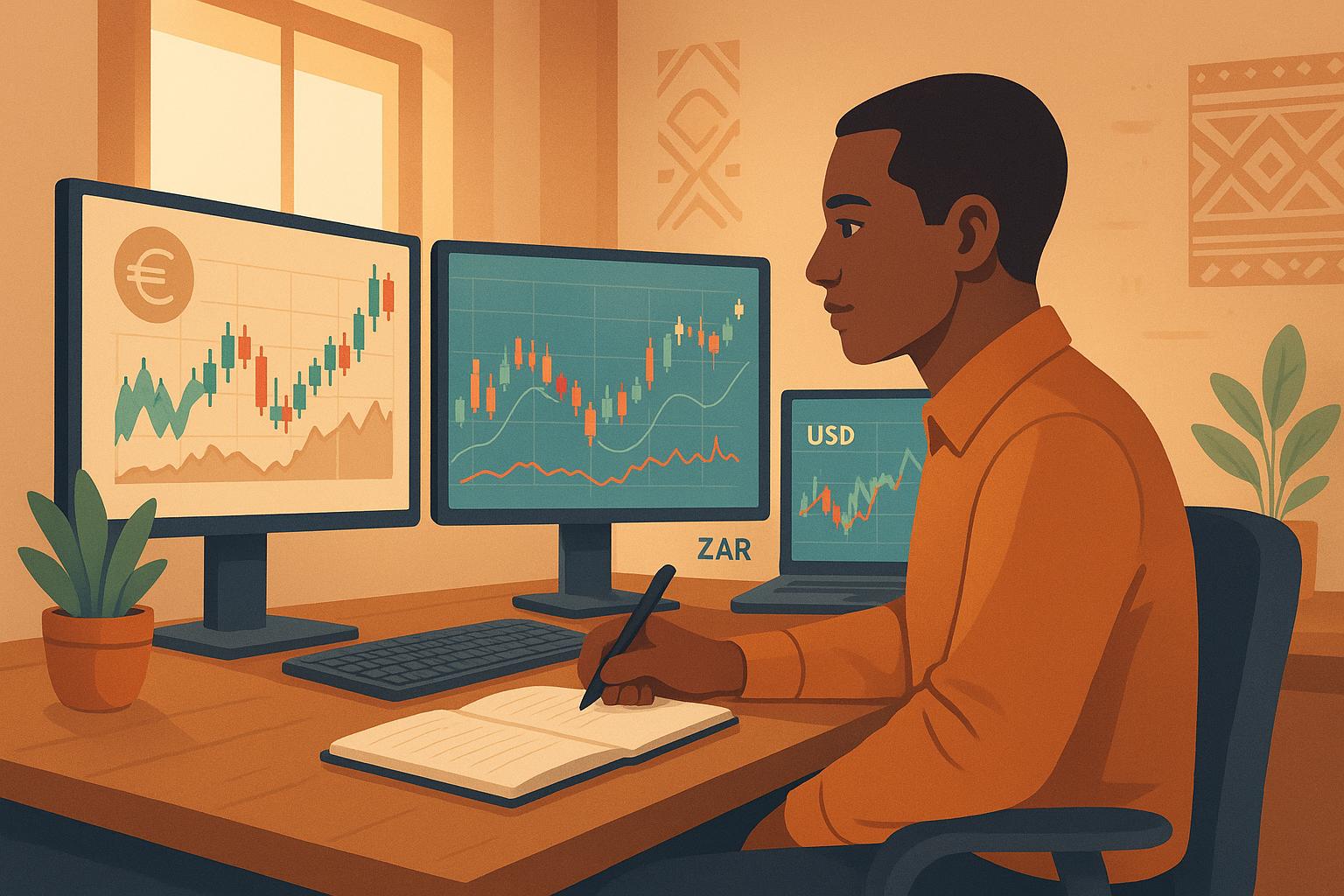Want to trade forex in South Africa without losing your shirt? Here’s how to manage your risks like a pro.
The South African forex market is fast-paced and influenced by global trends, making risk management crucial. Whether you’re trading USD/ZAR or EUR/ZAR, the following tips will help protect your capital:
- Set Risk Limits: Never risk more than 1-2% of your account per trade.
- Use Stop-Loss Orders: Protect your funds by setting stop-loss levels and trailing stops.
- Control Leverage: Stick to low leverage, especially if you’re new.
- Diversify Currency Pairs: Avoid putting all your money into one pair.
- Track Market Changes: Stay updated on economic and political events.
- Calculate Position Sizes: Use precise calculations to manage risk.
- Stick to FSCA-Regulated Brokers: Choose brokers that follow South Africa’s strict regulations.
- Keep a Trading Journal: Learn from past trades by recording your strategies and results.
Quick Tip: The FSCA ensures brokers operate responsibly, so always check their licensing before trading.
Forex Trading for Beginners in South Africa
South African Forex Market Overview
The South African forex market operates under strict oversight by the Financial Sector Conduct Authority (FSCA). With a global daily trading volume of around 100 trillion Rand, it’s essential for traders to understand both local and international market trends. This section highlights key aspects of navigating the ever-changing South African forex landscape.
The South African Rand (ZAR) has distinct trading traits. As an emerging market currency, it is especially influenced by global economic shifts and political developments.
Factors Affecting the Rand
The value of the Rand is shaped by several global factors, including:
- Decisions by the US Federal Reserve on interest rates
- Global debt trends
- Economic conditions in major economies
- Fluctuations in the strength of the US Dollar
FSCA Regulations and Protections
The FSCA enforces strict rules to ensure a secure trading environment. These include:
- Segregation of client funds: Brokers must keep client funds separate from their operating accounts.
- Regular audits: Brokers undergo routine checks to ensure compliance.
- Financial requirements: Brokers are required to maintain adequate cash reserves.
- Licensing standards: Brokers must hold OTC licences and operate under qualified non-executive directors.
The FSCA also provides tools like scam alerts, updates on broker statuses, and access to the Financial Services Tribunal, further strengthening trader confidence.
Local Trading Conventions
When analysing forex data, keep in mind these South African conventions:
- Currency symbol: The Rand is denoted by "R" and placed before amounts (e.g., R100).
- Banknotes in circulation: Common denominations include R10, R20, R50, R100, and R200.
- Key currency pairs: Popular pairs include USD/ZAR, EUR/ZAR, and GBP/ZAR.
Analysts predict heightened volatility in 2025 due to global economic uncertainties. Grasping these market characteristics and regulatory protections is crucial for effective risk management.
8 Risk Management Tips for South African Traders
These tips can help you manage risk effectively in South Africa’s forex market.
1. Set Your Risk Limits
Decide how much of your capital you’re willing to risk. A common approach is to limit losses to 1-2% of your total account per trade. For example, if your account is R100 000, avoid risking more than R2 000 on any single trade.
2. Use Stop-Loss Orders
Stop-loss orders are essential for protecting your funds. For ZAR currency pairs during trading hours (09:00-17:00 SAST), use the daily average true range (ATR) to set stops that account for market fluctuations. Trailing stops can also help lock in profits as the market moves in your favour.
3. Control Your Leverage
Stick to low leverage, especially if you’re still learning. The Financial Sector Conduct Authority (FSCA) provides guidelines to help traders manage leverage responsibly.
4. Trade a Mix of Currency Pairs
Consider trading a variety of pairs, such as:
- Major ZAR pairs: USD/ZAR, EUR/ZAR
- Cross rates: EUR/USD, GBP/USD
- Commodity-linked pairs: AUD/USD, USD/CAD
Be cautious about trading pairs that are closely correlated to avoid doubling your risk.
5. Keep an Eye on Market Changes
Stay informed about factors that can affect the Rand and other currencies, such as:
- Decisions by the South African Reserve Bank
- Economic data releases
- Global market trends
- Political events
6. Calculate Position Sizes
Proper position sizing is crucial. To calculate, divide the amount you’re willing to risk by the product of your stop-loss (in pips) and the pip value. This ensures you maintain consistent risk levels across trades.
7. Stick to FSCA-Regulated Brokers
Choose brokers regulated by the FSCA to ensure your funds are protected. These brokers follow strict rules, including keeping client funds separate and undergoing regular audits.
8. Keep a Trading Journal
Record details of each trade, including entry and exit points, position sizes, results, your reasoning, and the market conditions at the time. This helps you learn from past trades and refine your strategy.
Use the checklist below to keep your risk management on track:
| Risk Factor | Daily Check | Weekly Review |
|---|---|---|
| Position Size | Calculate max risk | Review total exposure |
| Stop-Loss | Set for each trade | Adjust for volatility |
| Leverage | Monitor levels | Check margin usage |
| Market News | Track daily events | Analyse weekly trends |
| Account Balance | Check available margin | Review performance |
sbb-itb-127c594
Risk Strategy Comparison
South African traders have several options for managing risk, each tailored to different trading styles and preferences.
Automated vs Manual Risk Control
Automated stop-loss orders automatically close a trade when it hits a pre-set price, helping to cap losses without requiring constant oversight. On the other hand, manual risk limits let traders decide exit points based on real-time market conditions. While manual methods provide more flexibility, they demand full attention and a disciplined approach to avoid emotional decisions.
Risk Management Methods Table
| Strategy | Benefits | Drawbacks | Best Used When |
|---|---|---|---|
| Automated Stop-Loss | – Automatically limits losses – Reduces emotional trading decisions |
– Limited flexibility in volatile markets | When consistent, emotion-free control is needed |
| Manual Risk Limits | – Offers flexibility to adjust to market trends | – Requires constant monitoring – Emotions can impact decisions |
When actively managing trades in stable markets |
This breakdown highlights how each approach works best under specific trading conditions, offering a clearer guide for traders to align their risk strategy with their goals.
RandFX Risk Management Tools

RandFX offers tools designed to assist South African forex traders in managing risk effectively. These tools work alongside the strategies discussed earlier, providing support for informed decision-making tailored to the local market.
Broker Analysis
RandFX evaluates brokers approved by the FSCA. This includes a detailed look at leverage ratios, deposit requirements, spreads, stop-loss options, and account protection features.
Live Market Updates
Stay informed with RandFX’s real-time market data and expert insights. This service helps traders respond quickly to market changes and adjust their strategies as needed.
Learning Materials
Access a wealth of resources covering topics like risk-reward ratios, trailing stops, drawdown management, and margin requirements to build your trading knowledge.
Broker Comparison Tools
Compare brokers based on margin requirements, platform features, and account protection options. These tools make it easier to choose a broker that aligns with your risk management goals.
Conclusion
Managing risk effectively is essential for navigating South Africa’s unpredictable forex market. It not only safeguards your trading capital but also supports sustainable growth over time.
Using well-defined risk limits and stop-loss strategies creates a solid base for trading. Traders who actively monitor their exposure and adapt their strategies to market shifts tend to see steadier outcomes. Following FSCA guidelines further ensures responsible trading practices.
RandFX’s risk management tools include:
- Real-time market insights
- Evaluations of FSCA-approved brokers
- Position size calculators
By combining these tools with sound risk management practices, traders can better navigate risks. These resources strengthen your overall approach to managing market uncertainty.
Successful forex trading in South Africa demands discipline. Applying these strategies consistently helps traders handle market volatility and work towards their financial objectives.
The real secret to long-term success? Treat risk management as a tool for empowerment, not a limitation. This mindset lets traders engage with the market confidently while protecting their capital. Whether you’re trading major currency pairs or focusing on ZAR-based crosses, these principles lay the groundwork for professional forex trading in South Africa.
FAQs
How do I check if my forex broker is regulated by the FSCA in South Africa?
To confirm if a forex broker is regulated by the Financial Sector Conduct Authority (FSCA), visit the official FSCA website and use their search tool to look up the broker’s licence details. Ensure the broker’s registration number matches the information on their website or promotional materials. Alternatively, you can contact the FSCA directly for verification. Always double-check this information to avoid dealing with unregulated brokers.
How can I diversify my currency pairs effectively when trading forex in South Africa?
Diversifying your currency pairs is a key strategy to manage risk in forex trading. Start by avoiding reliance on a single currency pair. Instead, trade a mix of pairs that include both major and minor currencies, ensuring they are influenced by different economic factors. This can help balance potential losses with gains.
Look for currencies that tend to move independently of one another. For example, pairing a currency tied to a stable economy with one from a more volatile market can create a more balanced portfolio. Lastly, consider geographical diversification by including pairs from regions with different economic cycles, such as combining USD/ZAR with EUR/JPY. This approach can help you spread risk and adapt to market changes effectively.
How do global economic factors affect the value of the South African Rand in forex trading?
Global economic factors play a significant role in influencing the value of the South African Rand (ZAR) in forex markets. Events such as economic slowdowns in major economies like the US or Europe, geopolitical tensions (e.g. between the US and China), and rising global debt levels can create uncertainty, often leading to a weaker Rand.
The strength of the US dollar is another key factor. When the dollar strengthens, investors tend to favour it as a safer asset, which can put downward pressure on the Rand. Additionally, decisions by the US Federal Reserve on interest rates and key economic data from the US can shift capital flows, impacting the ZAR.
South Africa’s ties with BRICS nations and domestic factors, such as adherence to local regulations and political developments, also contribute to the Rand’s volatility. These dynamics highlight the importance of staying informed about both local and global economic trends when trading forex.

